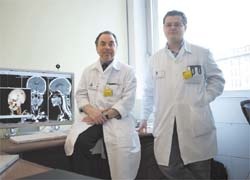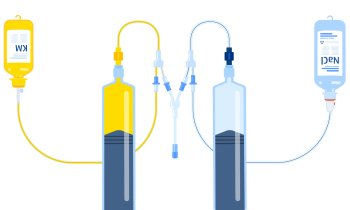OSIRIX
The 64-bit multimodality viewer
on the Mac Pro 8-Core workstation
Designed by a team of radiologists, the latest release of OsiriX 3.0.1 on the Mac Pro 8-core was demonstrated for the first time at the recent European Congress of Radiology (ECR). OsiriX - a powerful image processing software dedicated to DICOM images (.dcm / DCM extension) produced by imaging equipment (MRI, CT, PET, PET-CT etc.) and confocal microscopy (LSM and BioRAD-PIC format) - a multidimensional image display and analysis platform that supports peer-to-peer communication technology as an alternative to conventional PACS architecture, allowing wider access to images across medical enterprises.

The 64-bit programme can handle new generation imaging modalities combining anatomical and metabolic images (MRI, PET, CT, ultrasound, and angiographic images). It also provides dynamic display for time-varying images such as cardiac motion or metabolic functional studies.
The OsiriX creators say it provides an intuitive and user-friendly user interface tailored for physicians who are not familiar with complex image processing and manipulation techniques.
When Meike Lerner, of European Hospital, spoke with one of its developers, Osman Ratib MD PhD FAHA, Professor and Chair of Radiology of the Dept. of Medical Imaging and Information Sciences and Head of Nuclear Medicine Division at the University Hospital of Geneva, Switzerland, he explained that the idea to create OsiriX was born at UCLA in 2004, when he became annoyed that no known industry software could handle the huge amount of data produced by PET/CT scanners including 3-D dynamic images. He began to develop an open-source software with radiologist Antoine Rosset, who had a research grant to study at UCLA at that time. Their intention was for the free use of this new software by anyone who might need to modify it, which, he pointed out, would also mean the solution could benefit from large contributions. ‘That would be something way beyond what the industry had managed to do. Four years later, it worked much better than anticipated. 25,000 people around the world now use it. It has all the 3-D analysis and viewing tools that you can find on any commercial platform.’
The team chose to create the software only for Apple Mac, due to that system’s powerful graphics abilities. ‘However, even Apple wasn’t good enough. We had to put in some special video boards. But, we made that risky choice. We are very happy that Apple is now doing very well in that field, because we benefit from it. The machines are now so powerful that we don’t need any special graphic boards anymore. The software runs on any Mac. Yes, the fact that there are not many Apple users is a problem, but it turns out to be an advantage, because many physicians are actually looking for a reason to use a Mac. Hospitals may not want it, but the physicians, the radiologists, want it. In many hospitals the Mac platform is slowly making its way in addition to the existing Windows machine. The IT departments are usually very reluctant, and Apple is very aware of that. Essentially there are no technical problems, especially now that Apple can run Windows applications at a much better cost and much faster. But yes, IT departments in hospitals are reluctant to integrate – I experienced this first hand when I was head of IT at UCLA, so I’ve been struggling to demonstrate that a hybrid environment is possible. We really see an advantage for users in terms of rapid adoption. We have had presentations at various hospitals, when OsiriX was integrated. The average training time is in the range of 60 to 90 minutes, then the users are not heard from again; they don’t ask questions; they are usually capable of using the software by themselves. That’s usually not the case with other platforms.
‘We have identified 25,000 users who use OsiriX on a regular base, and these numbers come from machines that have visible unique IP addresses outside firewall and are visible. Other users are behind firewalls in hospitals and we don’t know about them. So we think there is double this number of users out there. Also, there are commercial companies that provide FDA and CE certified versions of the software.
‘In current multicore Apple machines, OsiriX provides real time rendering and visualisation of 3-D and 4-D images dynamically with extremely high performance. Users and radiologists can navigate through very large 3-D data sets in real time with a performance that matches very high-end commercial workstations.
‘There have been a lot of requests and attempts to move the software on Windows platform. Since the programme is Open Source, the source is available for free and can be copied. However, the effort to move to Windows platform is significant and to achieve the same graphic performance is very challenging. Several groups have attempted to do it but so far there is no evidence that it is any closer to being done. In a large National Cancer Institute (NCI) project a decision was made to integrate Windows applications with OsiriX on the Mac platform instead of trying to import OsiriX to the Windows platform. Besides, OsiriX uses a lot of basic tools and core technologies that are imbedded in the Apple platform that don’t exist on the Windows platform. This includes all the powerful graphic capabilities of the Mac platform that are the reason for the success of the Macs in the graphic and editing industry, but also core technologies such as iChat, embedded databases and communication tools.
‘The Open Source option that we adopted is a new challenge. There are thousand of Open Source programmes out there, but only a few are successful. To be adopted by the user community an Open Source programme must be good. It is not enough just to be free. A programme that does not provide advanced tools and functions and is not robust enough, or crashes all the time, will be rapidly abandoned by users. The success of OsiriX resides in its design, done by radiologists for radiologists, and the robustness of its code, which makes it a very stable product for use in clinical and research applications. It is also a good development platform for programmers and researchers who want to add their own tools for image analysis.’
Indeed, OsiriX use has already broadened into research in biology, astronomy, molecular imaging and archaeology. It is a generic image display and rendering that can be used in many other areas than medicine.
‘Fully leveraging the Leopard operating system and the Mac user interface, the 64-bit OsiriX programme offers functionality comparable with, or better than, the most advanced scanner consoles on the market. It’s also extremely fast and easy to use,’ Professor Ratib concluded.
Radiologist Dr Will Adair, at the Leicester Royal Infirmary, UK, another user of OsiriX, on his MacBook, added: ‘The combined OsiriX and Mac proposition has the potential to completely change the way we work by providing easy access to affordable, commercial-level image processing solutions with exceptional 3-D and 4-D capabilities.’
Further information:
www.osirix-viewer.com/
30.04.2008











